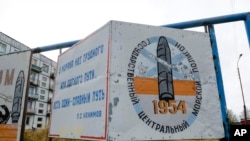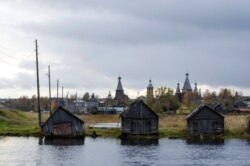Over Russian 100 medical workers who helped treat victims of a recent mysterious explosion at a military testing range have undergone checks and one man has been found with a trace of radiation, officials said Friday.
The Aug. 8 incident at the Russian navy's range in Nyonoksa on the White Sea killed two servicemen and five nuclear engineers and injured six. It was followed by a brief rise in radiation levels in nearby Severodvinsk, but authorities insisted it didn't pose any danger.
The Arkhangelsk regional administration said Friday that 110 medical workers have undergone checks, and that one man was found with a low amount of radioactive cesium-137 in his muscle tissue. It said the man's health isn't in danger and argued that he could have got the radioactive isotope with food.
The statement followed Russian media reports claiming that dozens of medical workers were exposed to radiation.
The reports claimed that medical teams at the Arkhangelsk city hospital hadn't been warned that they would treat people exposed to radiation and lacked elementary protective gear. They said that Russia's security agency forced the medical workers to sign non-disclosure papers.
The workers, who spoke on condition of anonymity fearing official reprisals, said many doctors and nurses felt angry about the authorities putting their lives at risk by concealing the vital information.
Contradictory accounts
Kremlin spokesman Dmitry Peskov shrugged off the reports, questioning the veracity of anonymous sources. He also alleged that certain forces that he didn't name could be interested in making false allegations about radioactive threats.
Russian officials' changing and contradictory accounts of the incident drew comparisons to Soviet attempts to cover up the 1986 explosion and fire at the Chernobyl nuclear power plant in Ukraine, the world's worst nuclear disaster.
The Russian Defense Ministry at first denied any radiation leak in the incident even as the authorities in nearby Severodvinsk reported a spike in radiation and advised people to stay indoors and close windows. Terrified residents rushed to buy iodine, which can help reduce risks from exposure to radiation.
Radiation readings
Russia's state weather and environmental monitoring agency said the peak radiation reading in Severodvinsk on Aug. 8 briefly reached 1.78 microsieverts per hour in just one neighborhood — about 16 times the average. Peak readings in other parts of Severodvinsk varied between 0.45 and 1.33 microsieverts for a couple of hours before returning to normal.
The Comprehensive Nuclear Test Ban Treaty Organization said earlier this week that several Russian radiation monitoring stations went silent shortly after the explosion. Observers saw that as part of an effort to conceal the radiation data, which could help determine the technology that was being tested at the time of the explosion.
President Vladimir Putin has hailed the victims, saying they were doing "very important work for the nation's security," but kept mum on what type of weapon they were testing. Some, including U.S. President Donald Trump, said the explosion occurred during tests of Russia's prospective Burevestnik nuclear-powered cruise missile that was code-named "Skyfall" by NATO.







